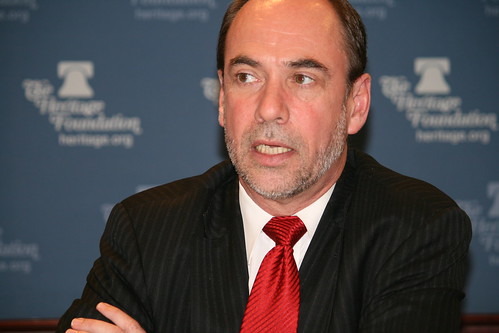The debt limit debate waits for the return of a recess-refreshed Congress, but if conservatives are ready for it, they can leverage the issue to enact spending caps and advance the budget the House passed last week, says former Congressional Budget Office director Douglas Holtz-Eakin.
“The Republicans should come back the day after the recess, pass the debt limit and attach to it caps to total spending that match the budget they just passed,” Holtz-Eakin, president of the American Action Forum, said this week at The Heritage Foundation Bloggers Briefing.
According to Holtz-Eakin, such immediate action could then serve as a bargaining chip for conservatives. The White House, after all, has asked Congress to dispatch this debate with all possible speed. If the House does, but the president refuses to sign the debt limit increase because of included spending caps, he undermines his own argument about the need for speed, Holtz-Eakin explained.
Last week at The Bloggers Briefing, Sen. Ron Johnson said much the same. “I think our maximum of leverage really is around that debt ceiling,” he said.
Yesterday, Heritage issued its own recommendations regarding the debt limit — and, similar to Holtz-Eakin’s, those suggestions include spending caps and reforms to the budget process itself.
“Congress should not authorize the government to borrow any more money to pay the government’s bills coming due without first setting the government firmly on the path to financial responsibility,” writes David S. Addington, Heritage vice president for domestic and economic policy.
“The least acceptable outcome,” he continues, “is for Congress to continue to raise the debt ceiling over and over, doing nothing to drive down federal spending and borrowing, and to pile trillions of dollars in debt upon the shoulders of America’s children and future generations.”
Whatever the result of the debt limit argument, the battle of the budget is likely to continue long into the future.
As Addington points out, even the most sweeping budget proposals currently on the table — including House Budget Chairman Paul Ryan’s plan and the alternative Republican Study Committee budget — are “useful budget proposals available to serve as a foundation upon which to base further actions necessary to cut future spending.” A foundation for further action, Addington says — not the last difficult decision to be made.
“In my view, this is the paramount issue of our time,” Holtz-Eakin, a former chief economist of the Council of Economic Advisers, said of the budget struggle. “The Pentagon has said it is the top national security issue.”
But the economist is not particularly optimistic about the federal government’s ability to come to a budget agreement.
“We’re seeing a failure of leadership in Washington,” he said. “Only the Republicans in the House have a plan and they don’t control enough to implement it. … The Democrat plan is to basically let the social safety net implode for all Americans.”
The S&P, of course, appears to agree that Washington will reach no consensus. In this climate, the debt limit debate takes on renewed, but still limited, importance. It’s a debate Congress can’t afford to waste, but no matter what it nets, it’ll be far from a final solution.






























